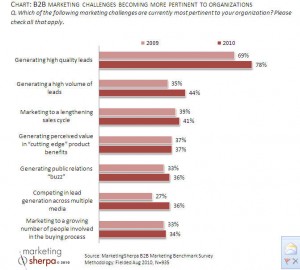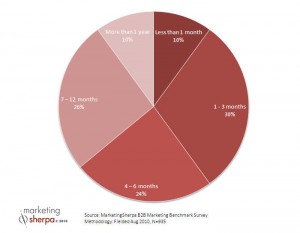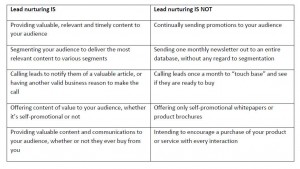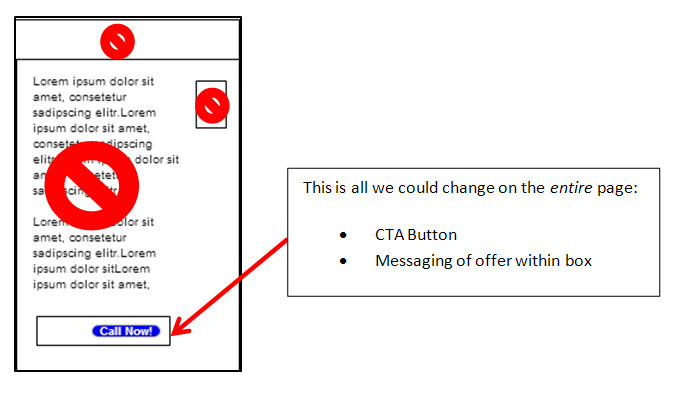We just launched the registration landing pages for our upcoming MarketingSherpa B2B Summits — the first will be held September 26-27 in Boston, and the second October 24-25 in San Francisco — and looking toward those events got me thinking about all the learnings I’ve taken away from these last months of digging deeply into the complex world of B2B marketing.
Since I began covering the MarketingSherpa B2B beat toward the end of last year, I’ve had the opportunity to speak with many marketers, industry experts, and our internal researchers and thought leaders here at MECLABS (MarketingSherpa’s parent company). One area that really separates B2B from B2C marketing has come up many times — the complexity of the B2B sale and the length of the B2B sales cycle.
Our research, based on interviews with 935 B2B marketers in the MarketingSherpa 2011 B2B Marketing Benchmark Report, found marketing to a lengthening sales cycle as a growing concern, and the third-most-pressing challenge for B2B marketers today (trailing only quality and quantity of lead generation):

Click to make larger
That same report shows that more than one-third of B2B sales cycles from first inquiry to closed deal last seven months, or longer:

Click to make larger
During my B2B beat reporting I’ve learned quite a bit about three very interrelated marketing areas that address this challenge — the strategy of lead nurturing, the tactic of drip marketing campaigns and the use of marketing automation software tools.
Growing the lead into a sales-ready prospect
A lead generated is very rarely a lead ready to hand off to Sales, and when your sales cycle is measured in months, or even longer than a year, you want to have a lead nurturing program to keep in touch with that potential customer and turn them into a sales-ready lead.
Brian Carroll, Executive Director of Applied Research, MECLABS, explained to me that most lead nurturing programs don’t have an impact on conversion before at least five meaningful touches, and that the important thing is to continue nurturing leads whether it takes five touches or 25 touches to get them to the sales-ready point.
He says, “If you have a nine-month sales cycle, you should nurture a lead in those nine months, and that’s at a minimum level. So that means nine nurturing patterns during the course of that lead.”
Here’s a table from the 2011 B2B Marketing Advanced Practices Handbook outlining some lead nurturing basics:

Click to make larger
If you notice, content is a major aspect of that table. That’s because content marketing is a key element in lead nurturing. New information about your product is a good reason to reach out to the nurtured lead. So is a vendor-agnostic article from an industry thought leader that provides usable information or advice on your business area.
Other touches might include an invitation to an event, such as a webinar, or maybe an executive summary and key takeaway list from an event along with links to video or audio excerpts from the presentation.
Content marketing is not the only piece in a lead nurturing campaign, but it should be an area of high priority focus.
Keeping those touches coming
If lead nurturing is an overall strategy to meet the challenge of a long sales cycle, drip marketing is a specific tactic to execute that strategy. Drip marketing involves automatically sending marketing messages to your list via email or other methods. The messages are “dripped” in a series based on the specific behavior or status of the recipient.
Here’s Jeanne Jennings from a SherpaBlog post on drip marketing:
Drip campaigns take their name from drip irrigation, which saves resources by allowing water and fertilizer to be consistently delivered directly to the roots of plants. There’s less waste than with sprinklers and topical fertilizer application; drip irrigation also provides a consistent level of moisture to the soil, rather than the “soak and dry” experience that sprinklers provide.
Drip marketing campaigns are most commonly delivered via the email channel because of its short turn-around, quick delivery time and cost-effective nature. A drip campaign involves a series of messages that are sent or “dripped” in a predefined order at a predefined interval. Each message in the campaign stands on its own but also builds on the missives that have come before it. A drip campaign is a response to a specific behavior or status of the recipient – and it encourages a specific action.
… and then SkyNet took over
Actually April 19th has passed and I’m pretty certain no terminator robots are heading back in time as I write this post, but lead nurturing does have a powerful tool that makes the entire process much easier to manage — marketing automation software.
Marketing automation offers many benefits for marketers:
- It provides a trackable database and measurable analytic results for marketing efforts
- It, well, automates many marketing tasks that previously had to be handled manually
- For a long sales cycle, multi-touch lead nurturing campaign, it allows marketers to focus on determining the creative elements of the effort — email copy, content with each touch, etc. — and setting the timing and triggers for each touch, and the software handles the actual execution of the campaign
A small business with a handful of leads to nurture can most likely run the campaign manually. A large corporation with hundreds, thousands, or even many more leads will require marketing automation to run an effective lead nurturing program.
Related Resources
Members library – B2B How-To: 5 lead nurturing tactics to get from lead gen to sales-qualified
Members library – How-To Increase Relevance: Integrating drip marketing into an email campaign
No Budget and Less Time? Lead Nurturing in Five Simple Steps
Lead Marketing: Cost-per-lead and lead nurturing ROI
B2B Marketing: Calls-to-action and the business buying cycle
Members libarary — How and When to Use Content in the B2B Sales Process












